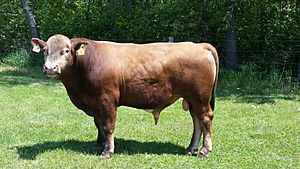Beefalo facts for kids
Quick facts for kids Beefalo |
|
|---|---|
 |
|
| Beefalo bull | |
| Conservation status | |
| Scientific classification | |
| Kingdom: | Animalia |
| Phylum: | Chordata |
| Class: | Mammalia |
| Order: | Artiodactyla |
| Family: | Bovidae |
| Subfamily: | Bovinae |
| Tribe: | Bovini |
| Subtribe: | Bovina |
| Hybrid: | Bos taurus × Bison bison |
Beefalo are a special kind of animal. They are a mix, or hybrid, of domestic cattle and the American bison. Usually, a male cattle is bred with a female bison to create them. Beefalo were created to combine the best features of both animals. The main goal was to produce meat.
Beefalo look mostly like cattle. Their genes are also mostly from cattle. A true Beefalo has about 37.5% bison genes. Animals with more bison genes are often called "bison hybrids."
Contents
How Beefalo Were Created
People first noticed accidental mixes of cattle and bison a long time ago. This was around 1749 in North America. The first time people tried to breed them on purpose was in the mid-1800s.
Early Breeding Attempts
One of the first people to try breeding bison with cattle was Colonel Samuel Bedson. He was a warden in Winnipeg, Canada, in 1880. Colonel Bedson bought eight bison. He bred them with a type of cattle called Durham cattle.
A famous nature expert, Ernest Thompson Seton, described these mixed animals. He said they were better than their parents. They were calmer and gave more milk than a bison. They were also tough like a bison. Their fur was nicer, and their body shape was improved.
"Cattalo" and Challenges
In 1886, many cattle died in a blizzard in Kansas. This made Charles "Buffalo" Jones want to create a tougher animal. He tried to cross bison and cattle near the Grand Canyon. He hoped these animals could survive harsh winters. He called his new animals "cattalo" in 1888.
Another person, Mossom Martin Boyd in Canada, also worked on these crosses. The Canadian government continued his work until 1964. But they did not have much success. For example, by 1936, they had only bred 30 cattalos.
It was hard to breed these animals. If a male bison bred with a domestic cow, there were few babies. But if a domestic bull bred with a bison cow, it worked better. The female babies from these crosses could have their own babies. But the male babies usually could not. This meant breeders had to keep wild bison cows, which were hard to handle.
The Rise of Beefalo
In 1965, Jim Burnett from Montana bred a male hybrid that could have babies. This was a big step! Soon after, Cory Skowronek started the World Beefalo Association. They began selling these new hybrids as a special breed.
They gave them the new name "Beefalo." This helped separate them from the older "cattalo" hybrids. The new name also showed they had solved the breeding problems. Today, a Beefalo is defined as having at least five-eighths (62.5%) cattle genes. It has at most three-eighths (37.5%) bison genes.
What Makes Beefalo Meat Special?
The United States Department of Agriculture studied Beefalo meat. They found it has less fat and cholesterol than regular beef. This is similar to bison meat.
How Beefalo Are Registered
In 1983, the main groups that registered Beefalo joined together. They formed the American Beefalo World Registry. Today, the American Beefalo Association, Inc. registers Beefalo in the United States.
Beefalo and Bison Conservation
Many bison herds today have some cattle genes. This means they are not completely pure bison. There are only a few American bison herds left that are genetically pure. Only two of these pure herds are also free of a disease called brucellosis. These are the Wind Cave bison herd in South Dakota and the Henry Mountains bison herd in Utah.
Dr. Dirk Van Vuren, a scientist, said something important about this. He explained that bison with some cattle DNA still look and act like bison. They are still bison. For groups working to protect animals, the main concern is that they are not 100% pure.
What is a Cattalo?
In the United States, "cattalo" means a cross between a bison and cattle that looks like a bison. But in Canada, "cattalo" can mean any mix of bison and cattle, no matter what they look like.
In some parts of America, cattalo are treated like "exotic animals." This is similar to pure bison or deer. However, in most states, bison and their mixes are raised for meat. In these cases, they are seen as domestic animals, like cattle. They do not need special permits.
See also
 In Spanish: Beefalo para niños
In Spanish: Beefalo para niños

